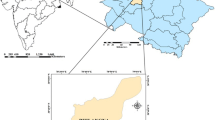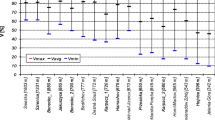Abstract
The displacement of a relatively small reactivated landslide in a snowy area in Japan was monitored over a long period. The displacement rate of the landslide, which was approximately of 20 mm d−1 before the formation of snow cover, decelerated drastically during the continuous snow cover period every winter period. Possible causes included reduction in the amount of water that reached the ground surface (MR: meltwater and/or rainwater) and increase in snow load. Given that the actual displacement of the landslide was far below the predicted value based on the relationship between landslide displacement and MR immediately before the continuous snow cover period, the deceleration of landslide displacement was more likely attributable to the increase in snow load than to the reduction in MR. An investigation of the link between snow load and landslide displacement showed a negative logarithmic relationship. A dynamic analysis based on the limit equilibrium method showed that snow load increases the effective normal stress and the stability of a landslide in which the mean inclination angle of the slip surface is smaller than the internal friction angle. The stability of the actual slope was also analyzed by conducting soil tests on samples collected at the site and using the resultant parameters. The analysis also showed that the increase in snow load increases the safety factor and reduces the landslide displacement. The displacement of a relatively small landslide that has a shallow slip surface was found to be greatly influenced by snow cover.













Similar content being viewed by others
References
Aoyama K, Nakamata S, Ogawa S (1984) Consideration on the relations between landslide and snow in Niigata prefecture. J Jpn Landslide Soc 21(3):11–16 (in Japanese with English abstract)
Chow VT (1964) Handbook of applied hydrology. McGraw-Hill, New York, pp 14–16
Dehn M, Bürger G, Buma J, Gasparetto P (2000) Impact of climate change on slope stability using expanded downscaling. Eng Geol 55:193–204
Enokida M (2001) On the influence of the indefinite elements on the stability analysis on presumption of effect of landslide countermeasures. J Jpn Landslide Soc 38(3):225–234 (in Japanese with English abstract)
Ishii Y, Ota K, Kuraoka S, Tsunaki R (2012) Evaluation of slope stability by finite element method using observed displacement of landslide. Landslides 9(3):335–348
Kamihara N (2002) Applications of a tank model to the stability evaluation of moving landslides. J Jpn Landslide Soc 38(4):301–309 (in Japanese with English abstract)
Kumagai A (1985) On the landslide preventative measures in Yamagata prefecture, Japan from recent landslide disasters. In: Proceedings of IVth international conference and field workshop on landslides 131–138
Matsuura S, Asano S, Okamoto T, Matsuyama K, Takeuchi Y (2003) Characteristics of the displacement of a landslide with shallow sliding surface in a heavy snow district of Japan. Eng Geol 69:15–35
Matsuura S, Matsuyama K, Okamoto T, Asano S, Takeuchi Y (2005) Fluctuation of the seasonal snowpack in a mountainous area of the heavy snow district in the warm-temperate zone in Japan. J Glaciol 51:547–554
Okamoto T, Matsuura S, Asano S (2008) Deformation mechanism of a shallow landslide in a snow-covered area. J Jpn Landslide Soc 44(6):358–368 (in Japanese with English abstract)
Sato H, Shiraishi S, Ito T (2004) The behavior of the tertiary landslides through the snowy period in Niigata Prefecture, central Japan. J Jpn Landslide Soc 41(1):37–42 (in Japanese with English abstract)
Scheffler H, Ullrich W (1981) Determination of drained shear strength of cohesive soils. In: Proceedings of 10th ICSMFE 10:775–778
Shibasaki T, Shinoda K, Yamasaki T (2008) Possible mechanism to explain various landslide behaviors during snow season. In: Proceedings of international conference on management of landslide hazards in the Asia-Pacific Region 809–817
Skempton AW (1985) Residual strength of clays in landslides, folded strata and the laboratory. Geotechnique 35(1):3–18
Stark TD, Eid HT (1994) Drained residual strength of cohesive soils. J Geotech Eng 120(5):856–871
Suzuki M, Umezaki T, Kawamani H, Yamamoto T (2000) Residual strength of soil by direct shear test. J Geotech Eng Jpn Soc Civ Eng 645/III-50:37–50 (in Japanese abstract with English abstract)
Author information
Authors and Affiliations
Corresponding author
Rights and permissions
About this article
Cite this article
Matsuura, S., Okamoto, T., Asano, S. et al. Influences of the snow cover on landslide displacement in winter period: a case study in a heavy snowfall area of Japan. Environ Earth Sci 76, 362 (2017). https://doi.org/10.1007/s12665-017-6693-7
Received:
Accepted:
Published:
DOI: https://doi.org/10.1007/s12665-017-6693-7




